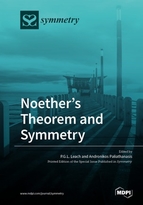Noether's Theorem and Symmetry
A special issue of Symmetry (ISSN 2073-8994). This special issue belongs to the section "Mathematics".
Deadline for manuscript submissions: closed (13 November 2019) | Viewed by 25182
Special Issue Editors
Interests: symmetries; integrability; differential equations
Interests: symmetries; integrability; collineations; gravitational physics
Special Issues, Collections and Topics in MDPI journals
Special Issue Information
Dear Colleagues,
In Noether's original presentation of her celebrated theorm of 1918 allowance was made for the dependence of the coefficient functions of the differential operator which generated the infinitesimal transformation of the Action Integral upon the derivatives of the depenent variable(s), the so-called generalised, or dynamical, symmetries. A similar allowance is to be found in the variables of the boundary function, often termed a gauge function by those who have not read the original paper. This generality was lost after texts such as those of Courant and Hilbert or Lovelock and Rund confined attention to point transformations only. In recent decades this dimunition of the power of Noether's Theorem has been partly countered, in particular in the review of Sarlet and Cantrijn.
In this special issue we emphasise the generality of Noether's Theorem in its original form and explore the applicability of even more general coefficient functions by alowing for nonlocal terms. We also look for the application of these more general symmetries to problems in which parameters or parametric functions have a more general dependence upon the independent variables.
Prof. P.G.L. Leach
Dr. Andronikos Paliathanasis
Guest Editors
Manuscript Submission Information
Manuscripts should be submitted online at www.mdpi.com by registering and logging in to this website. Once you are registered, click here to go to the submission form. Manuscripts can be submitted until the deadline. All submissions that pass pre-check are peer-reviewed. Accepted papers will be published continuously in the journal (as soon as accepted) and will be listed together on the special issue website. Research articles, review articles as well as short communications are invited. For planned papers, a title and short abstract (about 100 words) can be sent to the Editorial Office for announcement on this website.
Submitted manuscripts should not have been published previously, nor be under consideration for publication elsewhere (except conference proceedings papers). All manuscripts are thoroughly refereed through a single-blind peer-review process. A guide for authors and other relevant information for submission of manuscripts is available on the Instructions for Authors page. Symmetry is an international peer-reviewed open access monthly journal published by MDPI.
Please visit the Instructions for Authors page before submitting a manuscript. The Article Processing Charge (APC) for publication in this open access journal is 2400 CHF (Swiss Francs). Submitted papers should be well formatted and use good English. Authors may use MDPI's English editing service prior to publication or during author revisions.
Keywords
- Noether’s Theorem
- Action Integral
- Variational principle
- Continuous transformations
- Nonlocal transformations
- Invariant
- First integral
- Generalized Symmetry
- Boundary term
- Integrability






